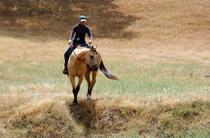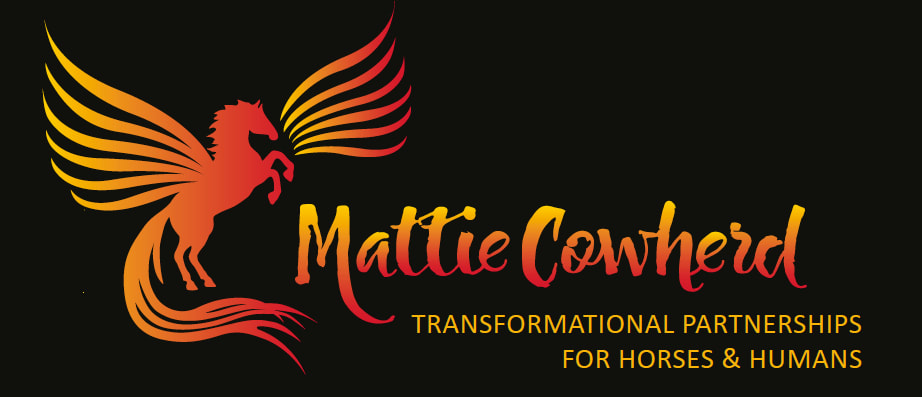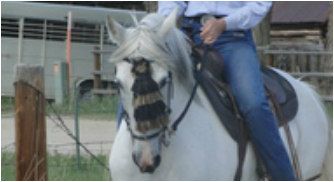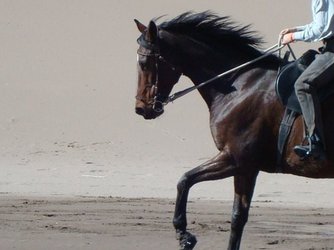|
By Mattie Cowherd  One of the biggest road blocks I hear from my students for Level 4 Finesse is their lateral movements. Common comments I hear sound something like this: “Laterals stink! Why are they so hard? They don’t work! I can’t tell where the feet are – I have no idea what all those fancy names are, or why I would want to do them. I am so confused, and the help I have received so far has only made me more so frustrated. Is it really this hard? What am I not getting?” One of my students even put it this way: “I felt like laterals turned my horse into an oversized Lay-Z-Boy recliner on cinder blocks!” The concepts of laterals can be quite complicated – case in point, pick up the nearest dressage training book, and you can see how many ways to manipulate your body and your horse’s body to “perform” a maneuver, while doing your best to look elegant, collected, and content. No wonder I don’t see smiling faces on many riders! If I had to think this hard about walking, I think I’d be tripping constantly. Surely, if it is something that horses and humans can do very naturally own their own, it would be easier to do the same maneuvers together. What are some ways that we as riders can make this easier? Taking the Basics Further: Connecting the Rein/Body Position to the Feet When I think of lateral maneuvers, I always try to relate them back to two things: the basic rein positions that all horses should learn (indirect and direct reins and lateral flexion) and where the horse’s weight needs to be in order to perform the maneuver. Lateral flexion at the halt will eventually translate to any flexion in the horse’s head and neck. For example: when a horse is making a circle to the right, he should have his head turned slightly to the right – even if it is only enough of a bend to see the horse’s eye and nostril. In fact, this slight bend, or arc, is usually all that you need for ANY lateral maneuver. You can choose which way the horse flexes his head and heck (even if it is counter to the direction of travel – hence the term “counter arc”). Our other two main basic rein positions are the indirect rein and the direct rein. The indirect rein is the rein you will use any time you want to influence the hindquarters of the horse. It is called “indirect” because of this. You are using the rein to move the opposite hind away from that rein, and cause the hind foot on the same side as the rein to step under the horse’s body. Your body weight needs to shift forward to encourage the front feet to stand still and to lighten and encourage the hind legs to move. The direct rein is the one that you will use to influence the forequarters of the horse. The rein is “direct” because the front foot is directly influenced by the rein on the same side. You can learn to control that front foot and even learn to place it into a position! You can lead the nose and the shoulder in the direction of the rein. Your weight needs to shift back onto the hind legs, in order to encourage the horse to “sit” and to lighten the front end. Your eyes also need to stay up so you don’t inadvertently weight the inside shoulder of the horse. Both of these reins will transfer to the appropriate set of feet to control your lateral maneuvers, so if the hind leg is trailing, use a slight indirect rein; if the shoulder needs to lead more, use a direct rein! (Homework alert: watch Level 2 FreeStyle for a review of Indirect and Direct Reins) The first lateral maneuver to practice is the side pass. A side pass is a straight sideways movement. The body needs to be straight so that the front and hind legs can cross equally and at the same time. You will use this maneuver for going sideways over obstacles, such as logs, as well as for opening and closing gates. This is a great exercise to start with, because it helps you learn to control the feet with your reins and body. You are going to need to fix one end of the horse or the other using your weight or leg position, and back these up with your reins in order to help your horse understand how to do this correctly (i.e. straight and equal, front and back!). Before we get into some more complicated maneuvers, let me mention a few tips for sideways maneuvers. · Tip #1: Most of the time when a maneuver isn’t working, it has to do with what your body is doing, especially your weight being in the “wrong” place (either too far forward – on the front end – or too far back, which is weighting the hind end). · Tip #2: If the maneuver feels hard, ride forward again immediately and check where your weight was or what rein position you were using. When you and the horse are in the correct balance, sideways should feel easy! · Tip #3: Pay attention to your focus. If you need more front-end movement, lift your eyes up; if you need more hindquarter movement, shift your eyes down. · Tip #4: In the beginning, give your horse a clear destination, such as a cone, so you both start to focus on the same place. · Tip #5: If your horse has trouble with the flexion of a maneuver (such as which way he should bend or look), start with a circle, go onto a straight line with the flexion for a few steps, and then go back to the circle to finish. · Tip #6: Have fun with them – sideways is always easier with exuberance! Advancing Sideways – Making it Fancy Now that we have some basics for our lateral maneuvers, let’s talk about some of the more advanced lateral maneuvers. The four maneuvers we will focus on are: leg yields, haunches in/out, shoulders in, and half pass. Each of these exercises builds on the previous by first creating flexibility, then strength, and then flexibility and then strength again. In the Classical Scale, you would build these exercises in this way: 1. Leg Yields – first off a circle, then in a straight line to create flexibility 2. Shoulder In – to start to build the horse’s strength and lighten the front end 3. Haunches In/Out – to create flexibility in the loins and strength in the hind leg 4. Half Pass – to create more strength and more lightening in the front end Though you can become quite technical in each of these maneuvers and really focus on exact foot-falls and tracks, let’s keep it simple for this article and talk about how these exercises relate back to the basic rein positions. Stretching Exercises: Based on the Indirect Rein Now that we have talked about the basic reins and positions and how the more advanced maneuvers should build on each other, let’s get a little more technical, starting with movements based on the indirect rein. Again, the indirect rein controls the hindquarters, and your body will come slightly forward to keep the front feet more still (don’t lean!). These maneuvers help create flexibility by softly stretching one side of the horse’s body at a time. The first of these maneuvers is the leg yield, and the second is the haunches in/out. A leg yield is a diagonal maneuver, in which the horse is going to walk forward and sideways equally. The horse will be in a counter arc and the weight is slightly tipped toward the leading shoulder. To ask for this maneuver, if you are going to do a leg yield to the left, you will slightly weight your horse’s front end and look down slightly (step into the stirrup, as Linda Parelli often says), asking for a slight right indirect rein. If your horse gets confused, you can also add leg support with your right leg. The leg yield is often the easiest maneuver for horses to learn, as they naturally want to “fall” onto the front end when they are traveling. This is a great exercise to help your horse learn to stretch the leading side, and it’s the first lateral maneuver introduced in the classical scale of training. Linda Parelli has also added it to her Finesse Training Sequence. Haunches in or haunches out is similar to a leg yield, but now you are asking the horse to start on a straight line and then move his hind legs slightly off the track of the front feet. The names “in” and “out” refer to where you are asking the horse’s hindquarters to move in regards to the center of the arena (X) – so if you are asking the horse to move his hindquarters away from the wall and toward the center of the arena, you are putting the hindquarters in. If you are asking the horse to put his hindquarters towards the wall and away from the center of the arena, you’re asking the horse to put its haunches out. When the hips move over, you are encouraging the horse to be more flexible in his loins. Also, when you move the haunches, one hind foot is going to step further under the body, which starts to build strength and power as well. Move the haunches, ask the horse to walk forward, and then shift your weight slightly forward and use your leg to push the hip off the line (if you are asking the hindquarters to move to the right, use your left leg and vice versa). If the horse gets confused, you can add an indirect rein as well. You don’t want the neck to bend, as the front feet should still be moving forward in a straight line. Both the leg yield and moving the haunches creates a horse that is more flexible and able to stretch its body. These maneuvers also help the horse become calmer, as the back and ribs start to relax. Strengthening Exercises: Based on the Direct Rein The maneuvers based on the direct rein are the shoulder in and the half pass. You are going to shift your weight back onto the hindquarters to lighten the front end, and then you are going to ask the front end to shift off the track. Since the hindquarters take more weight, you are going to build the horse’s strength to “sit” slightly behind. The shoulder in happens when you ask the shoulders to move off a track toward the inside of the arena. To perform this maneuver, shift your weight back onto the hindquarters and keep riding the horse forward. Ask the horse to shift his front foot over, off the main track, with a direct rein. To support the position for several steps, you can use the supporting rein to support the outside shoulder. Do in your body what you want your horse to do, by keeping your hips straight and lifting your sternum while turning your shoulders slightly. Keep your eyes up, too. The half pass is somewhat like a leg yield, in that you are going to ride forward and sideways equally, though now you are going to ask the horse to look in the direction of travel and bring his shoulders over slightly. You don’t want the hindquarters to trail behind (which would cause the movement to become a regular forwards again), so be prepared to “catch” them if they start to fall behind with an indirect rein, even while you are asking the horse to move the front end over. To ride a half pass, keep your weight back and your eyes up (at least the height of your arena wall – though the more you want the horse to elevate his front end, the higher you want to look). Both of these exercises really encourage the horse to build strength and the ability to carry his body more efficiently on the hindquarters. These will both result in a more collected horse. Simple Practice Exercises Call the Footfall When you are riding your horse, see if you can close your eyes and call out when each foot hits the ground --- do this for several feet with each footfall, before changing to another foot. Have a friend make sure you are calling the correct foot. Once you are good at this at the walk, trot, and canter, have your friend call out which foot you should be looking for as an added challenge. This exercise will help you know where each foot is so that you can then “feel” and influence it for lateral maneuvers. Ride on the Trail – Place the Foot When you are on a distinct trail or roadway with grass/dirt tracks, this is a great exercise to begin to teach the lateral maneuvers, and also keeps you from drilling the moves too much or asking for them too long in the beginning. Ride down the trail with a good forwards (freely forward). While moving forwards, see if you can ask either a front or hind foot to step off the main track for a step or two, and then return to the track. Think about “putting” the foot onto the grass, for example, but DON’T LOOK DOWN! Keep your eyes up and in the direction of travel. Build up to several steps with each foot. Once you are good with one foot at a time, start to play with walking forward and sideways at the same time. Start on one side of the track, and while keeping the horse’s body parallel to the track and still moving forwards, ask your horse to move sideways to the other side of the track. You can also do this on a road once the horse’s confidence has built up. Once the sideways feels easy, see if you can start shaping it for one of the lateral maneuvers. This exercise gives you and your horse a clear destination, and helps you know exactly where you are going. It also helps keep things simple and clear. It can be quite fun! To translate this to an arena later, simply imagine a “track” in the arena and ride it just like you did out on the road or trail. Riding the Maneuvers: It Should Feel Easy! These advanced riding maneuvers are useful skills to add to your training arsenal. Each exercise helps a horse develop strength, straightness, flexibility, and overall balance. Lateral maneuvers are not something to expect overnight. See if you can pepper them in at fun times during your rides. You can even take advantage of a “crooked” horse by pretending that their body position was on purpose – such as when a horse comes around a corner and falls in slightly: “Thank you! I wanted to practice that shoulder in here!” Your attitude towards sideways should be fun and playful. Realize that your horse may be using muscles that he doesn’t normally use. If something doesn’t work, laugh and try it again. It should feel like a dance, and the moment it does not feel that way, ride forwards again. When one of my students started to understand this concept of lightness and controlling the weight and feet, she described lateral movements like this: “I think it's the difference between pushing a chair and pushing a ball. Now I'd say she's like a lawn chair; pretty soon she'll be light as a ping pong ball, but being a lawn chair is better than my horse being a Lay-Z-Boy!” Just wait until your horse becomes a ballet dancer! Review of the Terms (Bolded Above) Basic Rein Positions: Lateral flexion, indirect rein, and direct rein. For a review of these basic rein positions, watch Level 2 FreeStyle. The Horse’s Weight: The set of limbs with which the horse is carrying the majority of his body weight, and also a shift in a horse’s balance. Think of this with humans – you can put your weight on one leg or the other, lean forward and backwards or even sideways, etc. Lateral Flexion: A horse flexing his head and neck. In the basic form, this means that the horse will bend his head to the side at the halt. In more advanced forms, the head and neck will turn to varying degrees. Arc: A bending of the horse’s body in the direction of travel. For example, the horse is trotting on a circle to the right and has his head bent to the right slightly. Counter Arc: A bend in the opposite direction of the horse’s travel. For example, the horse is traveling a circle to the right, but his head and body are bent slightly to the left. Indirect Rein: The rein you will use any time you want to influence the hindquarters. You are using the rein to move the opposite hind away from that rein, and cause the hind foot on the same side as the rein to step under the horse’s body. Your body weight needs to shift forward to encourage the front feet to stand still and to lighten and encourage the hind legs to move. Direct Rein: The rein that you will use to influence the forequarters. The rein is “direct” because the front foot is directly influenced by the rein on the same side. Your weight needs to shift back, onto the hind legs, to encourage the horse to “sit” and to lighten the front end. Your eyes also need to stay up, so you don’t inadvertently weight the inside shoulder of the horse. Leg Yield: A diagonal maneuver in which the horse is going to walk forward and sideways equally. The horse will be in a counter arc and the weight is slightly tipped toward the leading shoulder. Haunches In: You are asking the horse to start on a straight line and then move his hind legs slightly off the track of the front feet by putting the hindquarters closer to the center of the arena (and away from the rail). Haunches Out: You are asking the horse to start on a straight line and then move his hind legs slightly off the track of the front feet by putting the hindquarters away from the center of the arena (and toward the rail). Shoulder In: You ask the shoulders to move off a track toward the inside of the arena. Half Pass: You ride forward and sideways equally and ask the horse to look in the direction of travel, and bring his shoulders over slightly. You want to make sure the hindquarters continue to carry weight and step under the body, too.
2 Comments
|
Archives
March 2020
AuthorMattie Cowherd loves sharing her passion for horses, nature, and learning. Join her for some fun thoughts and adventures. Mattie loves writing, teaching, horse care, and --- well --- horses! Categories |

Holistic Equine Partnerships - Care, Instruction, and Healing Natural Horsemanship Instruction and Training Performance Horse Barefoot Hoof Trimming and Bodywork |
Mailing Address:
P.O. Box 247 Bayfield, CO 81122-0247 Phone: (970) 880 - 2844 Email: [email protected] |








 RSS Feed
RSS Feed